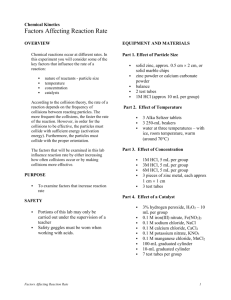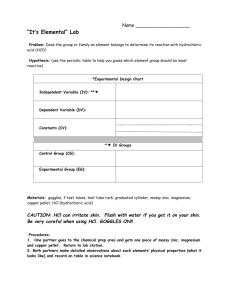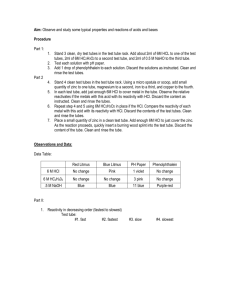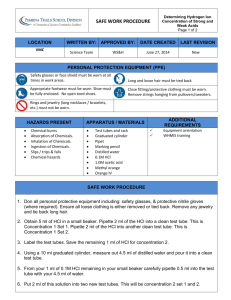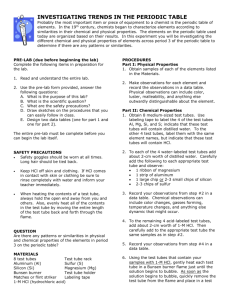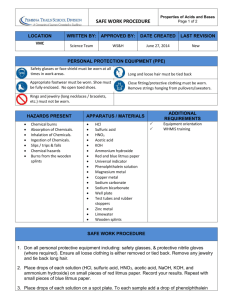Lab #2 Chemical Kinetics - Westgate Mennonite Collegiate
advertisement
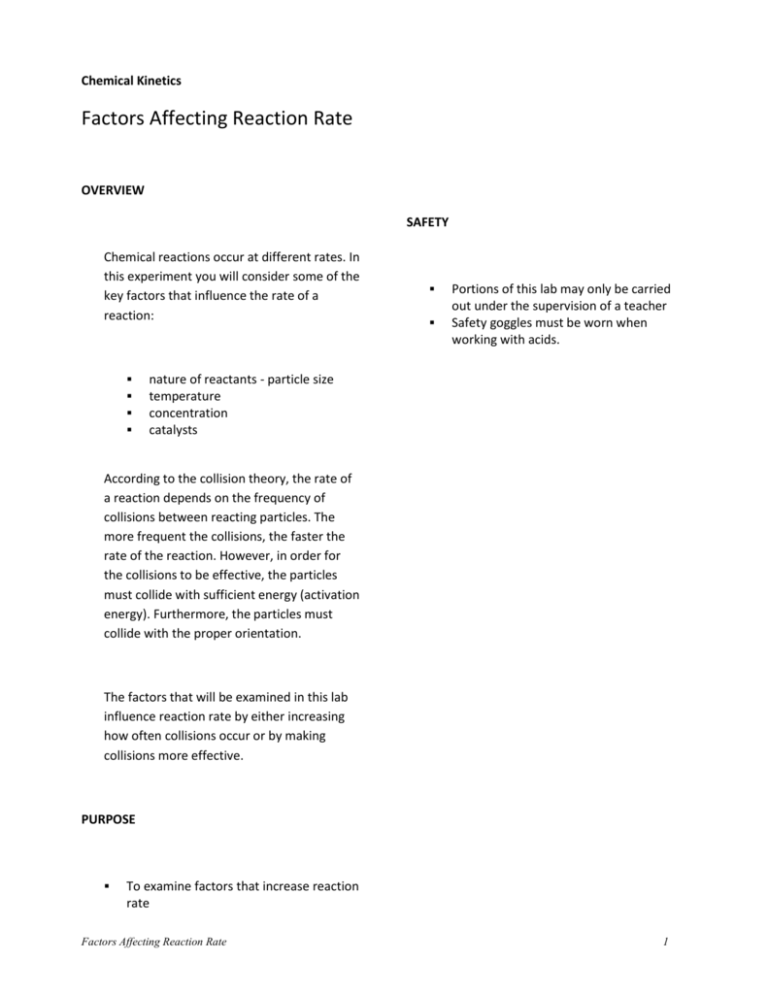
Chemical Kinetics Factors Affecting Reaction Rate OVERVIEW SAFETY Chemical reactions occur at different rates. In this experiment you will consider some of the key factors that influence the rate of a reaction: Portions of this lab may only be carried out under the supervision of a teacher Safety goggles must be worn when working with acids. nature of reactants - particle size temperature concentration catalysts According to the collision theory, the rate of a reaction depends on the frequency of collisions between reacting particles. The more frequent the collisions, the faster the rate of the reaction. However, in order for the collisions to be effective, the particles must collide with sufficient energy (activation energy). Furthermore, the particles must collide with the proper orientation. The factors that will be examined in this lab influence reaction rate by either increasing how often collisions occur or by making collisions more effective. PURPOSE To examine factors that increase reaction rate Factors Affecting Reaction Rate 1 EQUIPMENT AND MATERIALS 100-mL graduated cylinder 10-mL graduated cylinder 7 test tubes per group Part 1. Effect of Particle Size solid zinc, approx. 0.5 cm 2 cm, or solid marble chips zinc powder or calcium carbonate powder balance 2 test tubes 1M HCl (approx 10 mL per group) Part 2. Effect of Temperature 3 Alka Seltzer tablets 3 250-mL beakers water at three temperatures – with ice, room temperature, warm (around 70C) Part 3. Effect of Concentration 1M HCl, 5 mL per group 3M HCl, 5 mL per group 6M HCl, 5 mL per group 3 pieces of magnesium metal, each approx 1 cm 1 cm 3 test tubes Part 4. Effect of a Catalyst 3% hydrogen peroxide, H2O2 – 10 mL per group 0.1 M iron(III) nitrate, Fe(NO3)3 0.1 M sodium chloride, NaCl 0.1 M calcium chloride, CaCl2 0.1 M potassium nitrate, KNO3 0.1 M manganese chloride, MnCl2 Factors Affecting Reaction Rate 2 PROCEDURES Part 2. Effect of Temperature Part 1. Effect of Particle Size on Reaction Rate 1. Half fill three 250-mL beakers with water. In one beaker add several ice cubes. A second beaker will contain water at room temperature. In the third beaker add water that has been heated to about 70C. Powdered calcium carbonate and marble chips may be used instead of zinc Zn + 2 HCl ZnCl2 + H2 2. Record the water temperature in the three beakers, then add an Alka Seltzer tablet to each. CaCO3 + HCl CaCl2 + H2CO3 3. Record the time it takes for the Alka Seltzer tablet to completely dissolve. 1. Obtain a piece of solid zinc metal, approximately 0.5 cm 2 cm. Find the mass of this sample, and place it in a test tube. 2. Using the balance obtain a sample of powered zinc that is close to the mass of your piece of solid zinc. Place this sample in the second test tube. Caution: powdered zinc is flammable. 3. Place both test tubes in a test tube rack. Add 5 mL of 1M HCl to both test tubes. Be sure to wear your safety goggles. 4. Observe both test tubes and record your observations and record your observations in the data table. Factors Affecting Reaction Rate 3 Part 3. Effect of Concentration Mg + 2 HCl MgCl2 + H2 3. Place 5-mL of the 0.3% H2O2 solution into each of the 7 test tubes. 4. Add 5 drops of each of the following solutions to separate test tubes: 1. Pour 5 mL of each of the three HCl solutions into separate test tubes. Place the test tubes in a test tube rack. 0.1 M FeCl3 0.1 M NaCl 0.1 M Fe(NO3)3 0.1 M CaCl2 0.1 M KNO3 0.1 M MnCl2 2. Add one piece of magnesium to each test tube. 5. Mix each tube by swirling the test tube or gently stirring with a clean stirring rod. 3. 6. Observe each solution, noting the production of any gas bubbles that form. Record each reaction rate as fast, slow, very slow, or none in your data table. Record the time you added the magnesium to the tubes, and the time each reaction stops. Also record your observations for each tube. Part 4. Effect of a Catalyst RESULTS In this part of the lab you will determine which substance/substances act as a catalyst for the decomposition of hydrogen peroxide. Record your results for each part of the lab in the data tables provided on the following page. CONCLUSIONS 2 H2O2 2 H2O + O2 1. Dilute the hydrogen peroxide by adding 10 mL of 3% H2O2 to a 100-mL graduated cylinder. Add 90 mL of distilled water to obtain 100 mL of diluted (0.3%) hydrogen peroxide. 2. Use a small amount of this solution to rinse out a 10-mL graduated cylinder and 7 test tubes. Pour the rinses away. Factors Affecting Reaction Rate For each part of this lab present your results and conclusions in formal lab report format. A paragraph will be sufficient for each of the four parts to this lab. In clearly worded and complete sentences describe what reactions were carried out and present your observations findings. When possible include the chemical equation involved. Refer the reader to the appropriate data table (for example – “See Table 1.”). Use collision theory to explain your findings. 4 RESULTS Table 1. Effect of Particle Size on Reaction Rate Substance Tested Observations powdered zinc or calcium carbonate solid zinc or marble chips Table 2. Effect of Temperature Water Condition Time to Completion Water Temperature (C) cold room temperature warm Table 3. Effect of Concentration Acid Concentration Time at Completion Start Time Observations 1 M HCl 3 M HCl 6 M HCl Table 4. Effect of a Catalyst Possible Catalysts FeCl3 NaCl Fe(NO3)3 CaCl2 KNO3 MnCl2 Reaction Rate Factors Affecting Reaction Rate 5 Factors Affecting Reaction Rate 6
